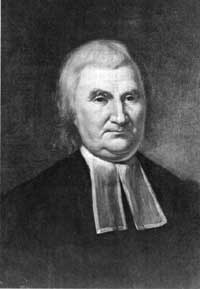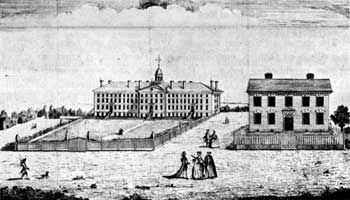







Biographical Sketches
|
JOHN WITHERSPOON New Jersey |
 John Witherspoon | |
| ||
The son of a Calvinist minister, Witherspoon was born in 1723 at the village of Gifford, near Edinburgh. He attended grammar school at the neighboring town of Haddington and won master of arts (1739) and divinity (1743) degrees from the University of Edinburgh. In 1743 the Haddington Presbytery licensed him to preach. He was ordained 2 years later at Beith, where he occupied a pulpit until 1757. He then transferred to Paisley, not far from Glasgow. Meantime, in 1748, he had married; only five of his ten children survived childhood.
Over the years, Witherspoon attained leadership of a group of conservative clergymen who were engaged in a prolonged struggle with a group of their colleagues to maintain the "purity" of orthodox Church doctrine. Witherspoon penned a stream of sermons and tracts attacking the opposition and denouncing moral decay in Scotland. He also defended the traditional prerogative of the people to choose their own ministers, a right ecclesiastical authorities had taken from them.
 |
| The College of New Jersey (later Princeton University) in 1764. Rev. John Witherspoon served as its president from 1768 until 1794. The main building, Nassau Hall, is on the left; the President's House, on the right. (Engraving by Henry Dawkins, after W. Tennant, from An Account of the College of New Jersey, 1764, Library of Congress.) |
In 1768 Witherspoon channeled his energies in a new direction. He gave up his post at Paisley and accepted the presidency of the College of New Jersey, after two representatives of the college had visited him and finally at the end of 2 years of effort overcome the objections of his wife. He sailed to America with his family. The college bloomed under his direction. He increased the endowment, instituted new methods of instruction, and broadened and revitalized the curriculum. Continuing also as a minister and church leader, he patched up a major schism in the Presbyterian Church; stimulated its expansion, especially in the Middle Colonies; and worked closely with the Congregationalists.
The Revolution fanned Witherspoon's hatred of the English, which had originated in Scotland. By 1770 his students were openly demonstrating in favor of the patriot cause. In a commencement oration he advocated resistance to the Crown, which became his favorite theme in sermons and essays. In 1774-76 he represented his county in the New Jersey provincial assemblies, and sat on local committees of correspondence. In the latter year he figured prominently in the agitations that led to the removal from office and imprisonment of the Royal Governor, and then received an appointment to the Continental Congress.
On July 2, 1776, in a congressional speech urging independence, Witherspoon declared that the Colonies were "not only ripe for the measure but in danger of rotting for the want of it." In November, when the British invaded New Jersey, he closed the College of New Jersey. The redcoats occupied its major building, Nassau Hall, burned the library, and committed other acts of destruction. The next year, Witherspoon's son James lost his life at the Battle of Germantown, Pa.
Witherspoon stayed in Congress until 1782. His main committee assignments dealt with military and foreign affairs. He also participated in the debates on the Articles of Confederation, aided in setting up the executive departments, and argued for financial stability. Meantime, in 1779, he had moved from the President's House at Princeton to Tusculum, a country home he had earlier built nearby. He left the Rev. Samuel S. Smith, his son-in-law and the college vice president, in charge of the nearly defunct institution.
Witherspoon devoted most of his effort during the postwar years to rebuilding the college, which never fully recovered its prewar prosperity during his lifetime. In addition, during the years 1783-89 he sat for two terms in the State legislature, attended the New Jersey (1787) convention that ratified the Federal Constitution, participated in the reorganization of the Presbyterian Church, and moderated its first general assembly (1789). In 1791, at the age of 68, Witherspoon took a second wife, a 24-year-old widow, who bore him two daughters. Blind his last 2 years, he died in 1794, aged 71, at Tusculum. His remains rest in the Presidents' Lot at Princeton Cemetery.
Drawing: Oil, ca. 1783, by Charles Willson Peale, Independence National Historical Park.
 |
 |
http://www.cr.nps.gov/history/online_books/declaration/bio54.htm
Last Updated: 04-Jul-2004